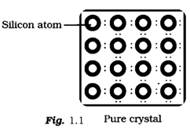A perfect crystal of silicon (Fig. 1.1) is doped with some elements as given in the options. Which of these options show n-type semiconductors?

There are two types of semiconductors, intrinsic and extrinsic semiconductors. Intrinsic, as shown in the question, are perfect crystals of the semiconductors like silicon. These have too low of conductivity to be of practical use. The conductivity is increased by “doping”, adding a suitable impurity in appropriate amount. The doped semiconductors are extrinsic semiconductors. Silicon belongs to group 14 of elements in the periodic table and contains four valence electrons. When it is doped with a group 15 element like P or As, which contains five valence electrons, they occupy some of the lattice sites in silicon the crystal. Four out of five electrons in P or As are used in the formation of four covalent bonds with the four neighbouring silicon atoms. The fifth electron becomes delocalized which leads to increase in conductivity. Silicon doped with electron-rich impurity is called n-type semiconductor because the conductivity increase is due to negatively-charged electrons. Therefore, the semiconductors doped with As and P are n-type semiconductors.
Hence, option (i) and (iii) are n-type semiconductors.